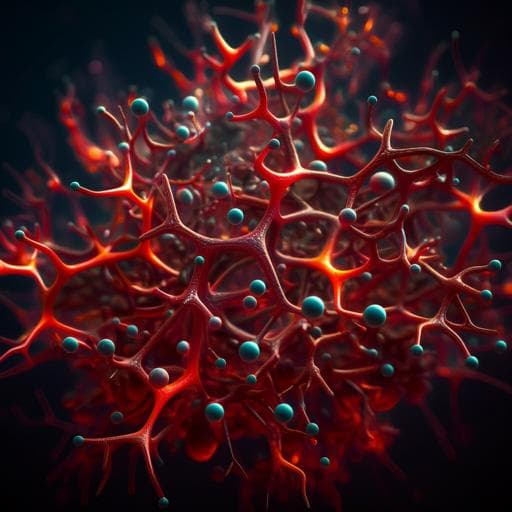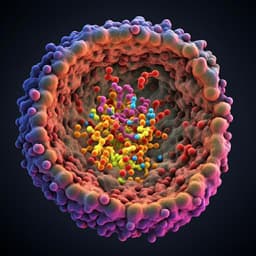
Engineering and Technology
Multiscale real time and high sensitivity ion detection with complementary organic electrochemical transistors amplifier
P. Romele, P. Gkoupidenis, et al.
This groundbreaking research reveals a new method for multiscale, real-time ion detection employing organic electrochemical transistors (OECTs) as amplifiers. Achieving sensitivity beyond the Nernst limit, this innovative technology promises enhanced performance in bioelectronics. The study was conducted by Paolo Romele and colleagues.
~3 min • Beginner • English
Introduction
The study addresses how to simultaneously detect absolute ion concentrations across a wide range and monitor small, clinically relevant deviations from resting levels in real time. Ions regulate critical biological processes, and small changes from equilibrium can indicate pathology (e.g., potassium deviations in serum, seizure-associated K+ and Na+ shifts). Conventional sensors often provide either wide-range detection or high sensitivity to small variations, but not both in a single, simple platform. The authors propose a circuit-oriented approach using a complementary organic electrochemical transistor (OECT) push–pull amplifier to combine local ion-to-electron transduction with in situ voltage amplification, aiming for multiscale ion sensing with low supply voltage and high sensitivity.
Literature Review
Prior ion sensing platforms include silicon, zinc-oxide, and graphene ion-sensitive FETs, porous silicon extended-gate FETs, amorphous IGZO dual-gate TFTs, organic electrolyte-gated FETs, and OECTs. OECTs are attractive due to volumetric ionic-electronic coupling, high transconductance, operation in aqueous media, and compatibility with flexible/low-cost fabrication. However, OECT-based ion sensors have largely been limited by the Nernstian sensitivity of ~59 mV/dec and typically require external amplification. A previous current-driven OECT architecture increased sensitivity but used a readout not ideal for real-time monitoring. Hence, achieving both wide-range quantification and small-variation tracking (multiscale detection) with high sensitivity and simple voltage readout remains challenging.
Methodology
Architecture and operating principle: The ion-sensitive amplifier consists of a complementary pair of OECTs (p-type and n-type) connected in series in a push–pull configuration. The input (electrolyte gate) voltage is common to both devices; the output voltage is at the joined drains; VDD biases the p-type source and the n-type source is grounded. Biasing at the inverter transition voltage VM (defined by Vo = VDD/2) yields high voltage gain so that small ion-induced shifts in transfer characteristics produce large output voltage changes.
Materials and device structure: The p-type OECT uses PEDOT:PSS; the n-type uses BBL. Both materials are stable in aqueous environments and show comparable ON currents. Channel geometries: p-type W = 200 µm, L = 50 µm; n-type interdigitated electrodes with W = 80 mm, L = 20 µm. Gold S/D electrodes with Cr adhesion on glass (26 × 76 mm²). Parylene-C bilayer insulates contact lines and enables peel-off polymer patterning.
Selectivity: Ion-selective membranes (ISMs) are integrated between gate and channel to confer ion specificity (demonstrated for K+). The ISM composition for K+: PVC 36.5 wt.%, potassium ionophore III 2.5 wt.%, potassium tetrakis(4-chlorophenyl)borate 0.5 wt.%, diisodecyl adipate 60.5 wt.% in THF, spin-coated and supported mechanically with a rubber ring and PDMS well. A filling solution (1 M NaCl) supports the ISM; analyte is confined in a top well.
Fabrication details: PEDOT:PSS (Clevios PH 1000) mixed with 5% ethylene glycol, 0.1 wt% dodecyl benzene sulfonic acid, 1 wt% GOPS; spin coat 1000 rpm 60 s; bake 140 °C 1 h. BBL dissolved in methanesulfonic acid (5 mg/ml), stirred overnight at 70 °C; spin coat 400 rpm 60 s; soak in DI water 1 h; bake 140 °C 4 h. Parylene-C used to encapsulate and pattern as described.
Electrical characterization: Electrolytes were KCl or NaCl solutions across concentrations 10−5 to 1 M; human blood serum used as received (starting K+ ~5×10−3 M). Gate electrodes: tin for PEDOT:PSS OECT, Ag/AgCl for BBL OECT. Measurements with dual Keithley 2636A; input swept 0 to VDD at 10 mV/s for transfer curves; microfluidics provided electrical connection and analyte housing. For high-sensitivity operation, Vin is set to VM determined from calibration (Vo–Vi curves vs concentration), then Vo is monitored over time as concentration is varied.
Modeling and design: Using Bernards–Malliaras OECT model, the inverter transition voltage VM depends on p- and n-type threshold voltages (VTp, VTn), current prefactors (Γp, Γn), and VDD: VM = (VTη + ηVDD)/(1+η), with η = (ΓpΓn)^1/2. Sensitivity of VM to concentration SM ≈ 0.5 ∂VTp/∂c (for η ≈ 1). High-sensitivity mode follows ΔVo/Δc = A SM, where A is the local voltage gain near VM and depends on OECT transconductance and output resistance, benefiting from OECTs’ high gm and ro. Sensitivity can be tuned via device parameters and supply voltage VDD (e.g., 0.3–0.5 V).
Key Findings
- Wide-range ion detection: The inverter transfer characteristics shift systematically with concentration, enabling calibration of VM versus ion concentration from 10−5 to 1 M with SM ≈ 30 mV/dec.
- High-sensitivity operation: Biasing at VM yields amplified ion-to-voltage response. Measured average sensitivities SA across ranges: 640 mV/dec (5×10−4–10−3 M), 837 mV/dec (5×10−3–10−2 M), 913 mV/dec (5×10−2–10−1 M), 1124 mV/dec (5×10−1–1 M). With K+-selective membranes, sensitivities of 703, 952, 995, and 1172 mV/dec over the same subranges are achieved at VDD = 0.5 V.
- Normalized sensitivity: Maximum SN = SA/VDD up to 2344 mV V−1 dec−1 at VDD = 0.5 V, exceeding the theoretical limit for transistor-based ion sensors over five decades (200 mV V−1 dec−1).
- Real-time detection: Small concentration steps (e.g., Δc = 7×10−5 M from a background of 5.4×10−4 M) produce ΔV ≈ 20 mV with response time ~11 s. Across concentration ranges, Δcmin/cmax ≈ 1% assuming ΔVo,min ≈ 5 mV.
- Selectivity: With K+-selective membranes, cross-sensitivity to Na+ is 33 mV/dec and to Ca2+ is 20 mV/dec, much lower than K+ sensitivities (~703–1172 mV/dec).
- Blood serum: In human blood serum with high Na+ background (1.36×10−1 M), K+ monitoring from 4.8×10−3 to 9.6×10−3 M yields SA ≈ 662 mV/dec. A <20% K+ increase (4.8×10−3 to 5.7×10−3 M) produces ~45 mV output change. Na+ spiking up to 2.72×10−1 M shows negligible response (cross-sensitivity ~44 mV/dec).
- Tunability: Sensitivity and dynamic subrange can be tuned by VDD: at cmin = 5×10−2 M, SA ≈ 913 mV/dec up to 1.8 cmin at 0.5 V; 483 mV/dec up to 2.8 cmin at 0.4 V; 267 mV/dec up to 3.8 cmin at 0.3 V.
- Low-voltage operation: All demonstrated at VDD ≤ 0.5 V; rail-to-rail output swing; real-time functionality.
Discussion
The complementary OECT amplifier integrates ion-to-electron transduction and local voltage amplification, addressing the key challenge of simultaneously quantifying absolute ion levels over a wide range and resolving small deviations around those levels in real time. High intrinsic gm and ro of OECTs enable large local voltage gain, translating small ion-induced threshold shifts into large output voltage changes. The achieved sensitivities surpass normalized theoretical limits for transistor-based ion sensors while operating at low supply voltages, and the architecture maintains selectivity via standard ion-selective membranes without sensitivity loss. The tunability via circuit parameters and VDD allows adapting sensitivity and operative windows to different application requirements, ensuring robust performance across physiological ranges and backgrounds. The approach is general and can enhance other transistor-based bioelectronic sensors where binding or recognition events induce small threshold voltage shifts, potentially improving signal-to-noise, resolution, and robustness for targets like metabolites, hormones, nucleic acids, proteins, and viruses, as well as single-molecule detection paradigms.
Conclusion
This work introduces a circuit-oriented, device-aware multiscale ion sensing platform based on a complementary OECT push–pull amplifier. It combines wide-range ion detection (10−5–1 M) with real-time, high-sensitivity monitoring (up to 1172 mV/dec at 0.5 V; normalized up to 2344 mV V−1 dec−1), enabling detection of concentration variations two orders of magnitude smaller than the background level and <20% deviations in blood serum K+. The method is tunable via supply voltage and device parameters, preserves ion selectivity with ISMs, and operates at low voltages suitable for biointerfaces. Future research can extend this multiscale amplification concept to diverse bioelectronic sensing modalities (immunosensors, metabolite and hormone sensors, nucleic acids, proteins, and viruses) and single-molecule transistor sensors, optimizing materials, architectures, and integration for enhanced, multifunctional bioelectronics.
Limitations
Explicit limitations are not detailed. Long-term stability in complex biological environments, membrane fouling, sensor drift, and broader multiplexed operation were not extensively characterized. Calibration at VM is required for high-sensitivity mode, and demonstrations focused primarily on K+ with selected cross-sensitivity tests.
Related Publications
Explore these studies to deepen your understanding of the subject.







